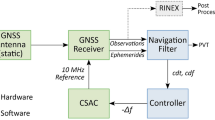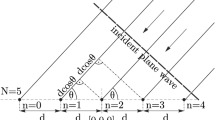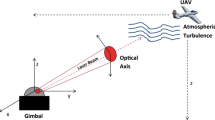Abstract
The ionospheric oblique backscattering sounding system can not only be used to detect the state of ionosphere and the condition of high frequency channel in real time, but also be used for over-the-horizon sounding. So, it has a very high military and civil value. For the characteristics of ionospheric oblique backscattering sounding, such as long sounding distance, wake echo, strong background noise, slow moving target, etc., a hardware platform of ionospheric oblique backscattering sounding system is designed. This platform adopts the technology of software radio and is designed as a new kind of general-purpose, modularized, software-based ionosonde that is based on VXI (Versa module eurocard eXtensions for Instrumentation) bus. At present, this hardware platform has been successfully used in actual ionospheric oblique backscattering sounding, and the experimental results demonstrate that this system can satisfy the demands of ionospheric oblique backscattering sounding preferably.
Similar content being viewed by others
References
Chong Yanwen, Xie Shuguo, Huang Tianxi. The Bitemporal Response Function Method in Studying the Ionospheric Movement [C]//Proc 5th International Symposium on Antennas, Propagation and EM Theory, Beijing: IEEE Press, 2000: 548–551.
Goutelard C, Fejzovski S. Pautot: Characterization of Scattering Functions by the New Concept of Complex Multi-Fractal [C]//Proc HF Radio Systems and Techniques, Guildford: IEE Press, 2000: 347–352.
Chen Xi, Zhao Zhengyu, Shi Yu, et al. Design and Implement of Main-Controller in Ionospheric Oblique Backscattering Sounding System[J]. Chinese Journal of Radio Science, 2005, 20(5): 598–603(Ch).
Chen Gang, Zhao Zhengyu, Shi Shuzhu. Design of the Wave-Form Generator of Ionosonde Based on Software Radio[J]. Systems Engineering and Electronics, 2005, 27(11): 1961–1965(Ch).
Mitola J. The Software Radio Architecture[J]. IEEE Communications Magazine, 1995, 33(5): 26–38.
Ning Baiqi, Lin Chen. Application of Software Radio in Ionospheric Radio Sounding[J]. Chinese Journal of Radio Science, 2002, 17(3): 286–290(Ch).
Colegrove S B. Project Jindalee: From Bare Bones to Operational OTHR[C]//Proc Radar Conference, Alexandria: IEEE Press, 2000: 825–830.
Dyson P L, Devlin J C, Parkinson M L, et al. The Tasman International Geospace Environment Radar (TIGER)—Current Development and Future Plans[C]// Proc IEEE International Radar Conference. Adelaide: IEEE Press, 2003: 282–287.
Liu Jinhua, Zhao Zhengyu, Chen Xuetao, et al. The Real-Time DSP Design of the Ionospheric Oblique Backscattering Sounding System[J]. Journal of Wuhan University (Natural Science Edition), 2003, 49(1): 132–136 (Ch).
Nie Xuedong, Zhao Zhengyu, Shi Yu, et al. Design of the HF Receiver for the New Type Ionospheric Oblique Backscattering Sounding System[J]. Journal of Wuhan University (Natural Science Edition), 2005, 51(1): 95–99(Ch).
Shi Yu, Zhao Zhengyu. Design of Receive Channel in the Radar System Based on Software Radio Technology[J]. Modern Radar, 2005, 27(9): 59–63(Ch).
Yang Xiaoniu, Lou Caiyi, Xu Jianliang. Principle and Application of Software Radio[M]. Beijing: Publishing House of Electronic Industry, 2001(Ch).
Liu Jinhua. The DSPs Design and Development of Ionospheric Oblique Backscattering Sounding System[D]. Wuhan: School of Electronic Information, Wuhan University, 2003(Ch).
Analog Devices Company. High Speed Over-Sampling CMOS ADC with 16-Bit Resolution at a 2.5 MHz Output Word Rate, AD9260[EB/OL].[2006-07-04]. http://www. analog.com.
Ge Wen. The Radar Receiver Technology [M]. Beijing: Publishing House of Electronics Industry, 2005 (Ch).
Intersil Company. Four-Channel Programmable Digital down Converter [EB/OL]. [2006-07-04]. http:// www.intersil.com.
Analog Devices Company. CMOS 200MSPS 14-Bit Quadrature Digital Up-Converter, AD9857[EB/OL]. [2006-07-04]. http://www.analog.com.
He Liang, Chen Zezong, Ke Hengyu. Selection and Design of System Bus in HF Ground Wave Radar Receiver[J]. Journal of Electronic Measurement and Instrument, 2005, 19(3): 5–8 (Ch).
Chen Guangju. The Technology of VXI Bus Test Platform[M]. Chengdu: The Press of University of Electronic Science and Technology of China, 1996 (Ch).
Yao Weilin, Zhao Zhengyu, Chen Xi. Design of the Signal Source Module for Ionospheric Oblique Backscattering Sounding System Based on VXI Bus[J]. Journal of Wuhan University (Natural Science Edition), 2005, 51(1):100–104 (Ch).
Author information
Authors and Affiliations
Corresponding author
Additional information
Foundation item: Supported by the National Natural Science Foundation of China (40474066)
Rights and permissions
About this article
Cite this article
Shi, S., Zhao, Z., Yang, G. et al. Design and implementation of hardware architecture in ionospheric oblique backscattering sounding system. Wuhan Univ. J. Nat. Sci. 14, 53–59 (2009). https://doi.org/10.1007/s11859-009-0112-1
Received:
Published:
Issue Date:
DOI: https://doi.org/10.1007/s11859-009-0112-1
Key words
- ionospheric oblique backscattering sounding
- software radio
- VXI (Versa module eurocard eXtensions for Instrumentation) bus




